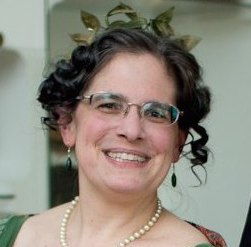Years ago, when I was working intensely on the “York set” of variations (see here, here, here, here, and here), I somehow skipped The Latest York, possibly because, unlike all those other “Yorks”, it does not feature the characteristic York step sequence of slide-close-slide-cut/close in “1&23” rhythm.
M. B. Gilbert published The Latest York in his Round Dancing (Portland, Maine, 1890) “by permission of Constantine Carpenter, Son, and Charles C. Martel”. This style of credit generally refers to the choreographer of the sequence and/or composer of the music. The same pair are also credited with the Gavotte Glide. Carpenter is listed in Gilbert’s directory of dancing masters as living in Philadelphia. Martel is not in Gilbert’s directory, but his name appears in Philadelphia newspapers (The Times, October 21, 1894, e.g.) during the 1890s offering parties and lessons.
Interestingly, The Latest York is one of the few dances from Gilbert that G. W. Lopp did not translate and reprint in La Danse (Paris, 1903).
My suspicion is that this is not so much the latest York in the sense of being the latest dance in the York family as a step-sequence published for or with a piece of music called “The Latest York”, meaning the latest tune in the York family. But I have so far located any surviving sheet music, so this remains speculative. In the meantime, here’s a quick description of how to dance it. The gentleman’s steps are give; the lady dances opposite.
The Latest York (four bars)
1,2 Slide left sideways along line of dance with a dip
&3 Chassé: close right to left and slide left to side
&1 Chassé: close right to left and slide left to side
2,3 Close right to left then slide left sideways, making half-turn
Repeat starting with right foot to complete a full turn every four measures
Notes
The second and fourth measures of The Latest York are similar to the parallel measures of La Russe, with what I jokingly call a “fake deux temps” movement – a slide-close-slide half-turn done to a 1-2-3 rhythm rather than the 1…&3 of the original valse à deux temps. I refer to it “fake” because it does not have the fast chassé integral to the galop and deux temps – the second movement is a close rather than a displacement. The difference between its use in La Russe and in The Latest York is that in latter, the first step of the second and fourth measures is the conclusion of a chassé begun on the upbeat.
The first and third measures do actually use a slight variation (adding the dip) of the “deux temps” step in its original rhythm, with the long slide and quick chassé at the end. The full sequence could be summarized as “deux temps with a dip, then chassé to initiate a ‘fake deux temps’ half-turn”. This makes it an interesting class exercise to help dancers distinguish the “1…&3” of the deux temps from a standard “1-2-3” rhythm.
While not specified, The Latest York works nicely with the standard nineteenth century changes of direction and turn — forward, backward, right turn, left turn. Full use of these helps make an otherwise not-very-exciting variation more interesting. The dancers just need to be careful to travel on diagonals and be sufficiently distant from the wall when traveling without turning.


Leave a Reply